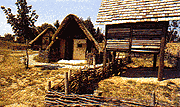Romans

in Nord Pas-de-Calais
|
Roman Britain, Gaul and
Belgium Boulogne was a major Roman port, linking the Empire's provinces of Gaul and Britain. There were matching lighthouses in Boulogne and Dover to help guide ships across the Channel. Extensive Roman remains were found in Bavay following bombing in the Second World War. Roman conquests |
|
|
 Ruins of Roman forum at Bavay |
Pax Romana During the gallo-roman period, the region became a part of the huge territory known as Belgium and was divided up into cities. Tarvanna, capital of the Morins, Bagacum, capital of the Nerviens and Nemetacum, capital of the Atrebates are all Roman creations. So much of the roman road network is still in evidence that it still has an influence on today's infrastructure (e.g. the Brunehaut roadway). The roads made their way towards the coast, Gesoriacum (or Bononia depending on the period), gateway to Roman Brittany, and towards the Rhine in the east and down to Italy. Life is still essentially rural and based upon wheat and wool. Christianity is scarcely evident, but Latin gradually supplants the Celtic language (except in the north). Prosperity translates into demographic growth even though the risk of further invasions is ever present. |
|
|
A bilingual region From the 3rd century AD, Franks (Germanic people originally from the east) and Alamans invade and pillage the land. Destruction is so widespread that the region requires recolonization using prisoners and the Romans, overwhelmed by the job of maintaining the Empire's borders, allow the Franks to settle, preferring to have them as allies. Hence, along the River Lys we find a linguistic frontier separating the Germanic dialect spoken by the Franks and which will later become Flemish, from Latin, the basis of today's French language. The region is deeply affected by the Bagaudes' revolt ; an act of self defense against the barbarians and against the authorities who were incapable of defending the cities. At the same time, part of the coast which was prone to encroachment by sea (as far inland as St Omer and Montreuil-sur-mer) is left to pillagers. Angles and Saxons settle, as witness some of the names of the villages and legends along the coast. |
||
|
Places to
visit: |
|
|
|
Related background
information |
|
|
|
|
|
